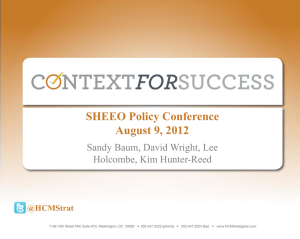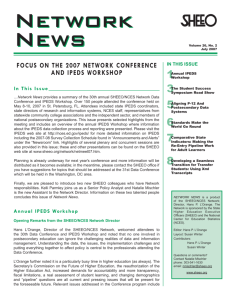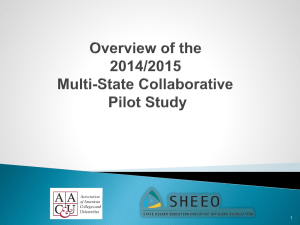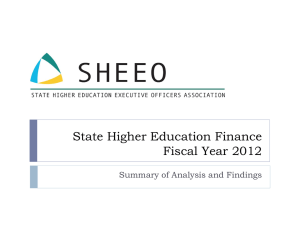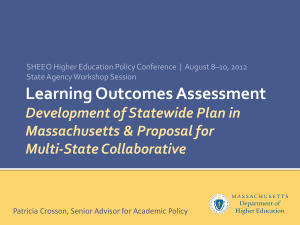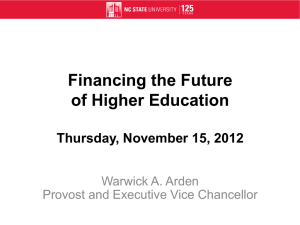view the strategic planning overview on this initiative
advertisement
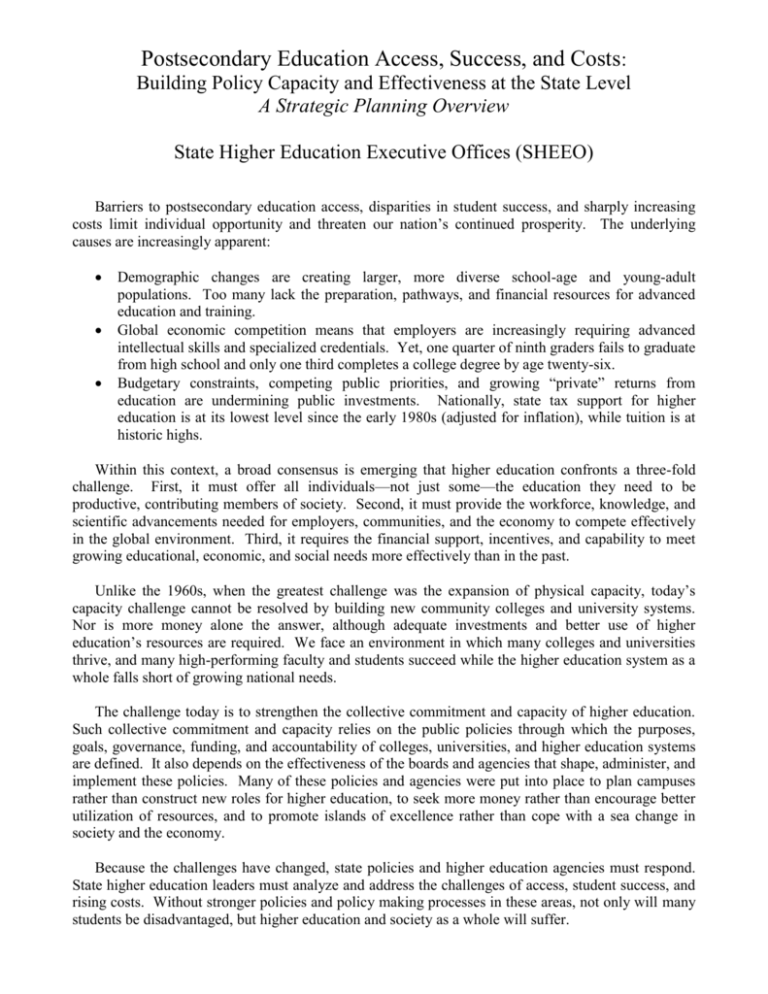
Postsecondary Education Access, Success, and Costs: Building Policy Capacity and Effectiveness at the State Level A Strategic Planning Overview State Higher Education Executive Offices (SHEEO) Barriers to postsecondary education access, disparities in student success, and sharply increasing costs limit individual opportunity and threaten our nation’s continued prosperity. The underlying causes are increasingly apparent: Demographic changes are creating larger, more diverse school-age and young-adult populations. Too many lack the preparation, pathways, and financial resources for advanced education and training. Global economic competition means that employers are increasingly requiring advanced intellectual skills and specialized credentials. Yet, one quarter of ninth graders fails to graduate from high school and only one third completes a college degree by age twenty-six. Budgetary constraints, competing public priorities, and growing “private” returns from education are undermining public investments. Nationally, state tax support for higher education is at its lowest level since the early 1980s (adjusted for inflation), while tuition is at historic highs. Within this context, a broad consensus is emerging that higher education confronts a three-fold challenge. First, it must offer all individuals—not just some—the education they need to be productive, contributing members of society. Second, it must provide the workforce, knowledge, and scientific advancements needed for employers, communities, and the economy to compete effectively in the global environment. Third, it requires the financial support, incentives, and capability to meet growing educational, economic, and social needs more effectively than in the past. Unlike the 1960s, when the greatest challenge was the expansion of physical capacity, today’s capacity challenge cannot be resolved by building new community colleges and university systems. Nor is more money alone the answer, although adequate investments and better use of higher education’s resources are required. We face an environment in which many colleges and universities thrive, and many high-performing faculty and students succeed while the higher education system as a whole falls short of growing national needs. The challenge today is to strengthen the collective commitment and capacity of higher education. Such collective commitment and capacity relies on the public policies through which the purposes, goals, governance, funding, and accountability of colleges, universities, and higher education systems are defined. It also depends on the effectiveness of the boards and agencies that shape, administer, and implement these policies. Many of these policies and agencies were put into place to plan campuses rather than construct new roles for higher education, to seek more money rather than encourage better utilization of resources, and to promote islands of excellence rather than cope with a sea change in society and the economy. Because the challenges have changed, state policies and higher education agencies must respond. State higher education leaders must analyze and address the challenges of access, student success, and rising costs. Without stronger policies and policy making processes in these areas, not only will many students be disadvantaged, but higher education and society as a whole will suffer. Building on What We Have Learned Since its establishment more than fifty years ago, SHEEO has played a central role in higher education policy development at both the state and national levels. SHEEO is the primary organization supporting capacity building and professional development for its state-based members—the chief executive officers of coordinating and governing boards, and their state-level academic, finance, government relations, information and communications officers. In the last two decades, SHEEO and its member organizations have focused increasingly on using information technologies to enhance organizational capacity, advance professional development, and shape policy debates and decisions. During the past several years in particular, SHEEO has collaborated with its state members and other policy organizations to support policy change in several key areas: The Pathways to College Network and report on Student Success: Statewide P-16 Systems provided direction and resources to state policy makers dealing with issues of college access, participation, and success. In the new annual survey and report, State Higher Education Finance (SHEF) and through participation in the Changing Direction project with the Western Interstate Commission for Higher Education (WICHE), SHEEO provided states with critical indicators and guidance on funding decisions. By collaborating in policy research, for example the Illinois State University project Recession, Retrenchment, and Recovery: State Higher Education Funding and Student Financial Aid, SHEEO has helped develop new analyses, understanding, and approaches to promote more balanced and predictable funding for higher education. Through its long-standing relationship with the National Center for Education Statistics, SHEEO has fostered federal-state collaboration in developing new approaches to higher education data reporting and analysis. With the assistance of the Carnegie Corporation, SHEEO has helped several states make progress on the challenging work of materially improving teacher preparation and professional development. As a result of the Ford Foundation supported National Commission on Accountability in Higher Education, SHEEO has stimulated both the national discussion and state initiatives to deal with issues of institutional and public accountability. With support from the Lumina Foundation for Education, SHEEO recently undertook a broad reexamination of the roles of information resources and technologies and the application of “knowledge management” approaches in state higher education policy. This re-examination involved team visits in Connecticut, Florida, Ohio, Kentucky, North Carolina, South Dakota, Texas, and Utah to explore and reflect on the knowledge management issues emerging both within these states and their respective SHEEO agencies. The visits and follow-up discussions tapped into a broad-based interest in re-examining states’ information needs in core higher education policy areas. The meetings typically involved between twenty and forty individuals from SHEEO agencies, other parts of state government, and institutions (public and private). The lively discussions covered new approaches for effective data collection and use, information sharing, “open-source” knowledge resources, and knowledge management concepts and practices used in other sectors of the economy and by higher education in other states. 2 The most important need that emerged from these discussions was the development of a set of problem-focused, easily-understood, data-based “tools” for dealing with the core components of state higher education policy. These tools must be designed to help all parties understand, communicate, and monitor the effectiveness of higher education policy in core areas, including costs and financing, student demography and preparation, access and equity, student progress and outcomes, and workforce/economic development. Encouraged by the Measuring Up reports produced by the National Center for Higher Education and Public Policy since 2000, policy makers are increasingly focused on comparative state performance in key areas. Linking performance to policy decisions, however, remains a significant barrier to improvement. Both new SHEEOs (many of whom come from other fields) and SHEEOs with many years of experience agreed that the effectiveness of higher education policy in core areas must be more clearly communicated and broadly understood. The second commonly identified need was for a reexamination and redesign of existing information systems. The Kentucky Council on Postsecondary Education, for example, is considering a major investment to redesign its information systems to serve internal data and policy needs better as well as link them more effectively with the state’s dispersed campuses and regional institutional clusters. Other states are continuing development of comprehensive, policy-oriented data and information sharing systems. Texas is expanding use of a cooperative K-12/higher education website with key indicators of student flow throughout its systems. Ohio is making its extensive data collection and warehousing system available to other states. And North Carolina is integrating data from community colleges and the state financial aid program with its university-wide information systems. These efforts are all aimed at designing and developing broader, more accessible, and policy relevant sources of information and knowledge. These state-level needs require forms of technical assessment and organizational assistance not typically available from hardware and software vendors—assistance that will promote collaboration among relevant partners, help states explore and develop new design concepts, and facilitate the sharing of experience and the coordination of policy objectives across states. The third need was for new and expanded forms of continuing professional development for those engaged in higher education policy. During the visits, we witnessed the importance of collaboration and communication in developing a coherent policy agenda, and saw examples of the types of organizational and cultural changes that will be required. Individuals and states engaged in making these changes readily acknowledged the need for different professional skills, as well as changes in existing organizational cultures and policy-making environments. Collaboration and partnerships, effective public communication, and the sharing of information resources and knowledge all help generate broader understanding and support for policy initiatives. SHEEO was frequently asked to expand and enrich its professional development activities to emphasize the skills and orientation now required, including: Resources and models for developing a public agenda for higher education; Strategies for promoting greater coherence across policy areas, including funding, student financial aid, and academic policy and planning; Communications techniques for reaching diverse stakeholders and audiences; and New forms of coordination and networking to support state-wide initiatives, particularly in areas requiring organizational change and cultural shifts. 3 Implications for SHEEO Planning and Work The rich veins of common interest struck during our state visits provide the basis for pursuing the following proposed initiatives: 1. Define and Develop Policy Tools Substantial unevenness in the information resources and knowledge about core areas of higher education policy across all fifty states underscores the need for consistent data definitions, standard analytic practices, and a more broadly shared “language” to communicate the purposes of higher education policy. The federal government has done much to promote uniform data elements and definitions, but much variability persists across areas of policy within and across states. This variability stems partly from the higher education policy-making process itself, which often requires ad hoc, demand-driven, discrete information. Longer-term planning and improvement require more analytic, comprehensive, and comparative forms of knowledge. There are also areas, such as the interstate mobility of students, where separate state data systems or aggregated national data by themselves are inadequate. To address core policy information and analytic needs, SHEEO will seek to develop a set of state policy information and analysis components, based on experience in developing the SHEEO State Higher Education Finance (SHEF) indicators, in the following areas: Resources and costs Student preparation and opportunity Workforce and economic development Collegiate learning processes and outcomes Research, public service, and quality of life Cost/benefit and return on investment In each area, SHEEO should give priority to developing a comprehensive set of higher education policy indicators and measures. For example, the financing component could be expanded to include—in addition to current SHEF revenue measures—major cost/expenditure components and measures of student net price and affordability. In other areas, SHEEO will identify the best available resources and data-use practices—for example, the demographic and workforce data and analytic and presentation tools developed by the National Center for Higher Education Management Systems (NCHEMS); student preparation data from ACT, the College Board, and the National Center for Public Policy and Higher Education; and student progress data from NCES and the growing number of state K-16 data systems. In these and other areas, SHEEO intends to synthesize existing data resources and define a consistent set of analytic practices. SHEEO will also work with states to advance appropriate definitions, measures, and indicators in several areas where substantial development work remains to be done (such as student learning and cost/benefit indicators). SHEEO’s experience in developing the SHEF survey and revenue measures indicates that when widely adopted and used in combination these policy tools can contribute significantly to a common language that focuses on the core issues of higher education policy and helps to link decisions to performance. 4 2. Promote and Assist State-Level Information Infrastructure Development SHEEO agencies are well aware of the potential of new technologies to meet growing information needs. Many also see opportunities for collaboration across the parties involved in developing these systems and improving their applications. Frequently, however, this awareness results only in a frank acknowledgement: Many states know that they can and should improve their information systems and see great potential in new technologies, but they do not know where to look for advice and models, and they do not collaborate with other states in meeting common needs and objectives. Also, it can be very expensive to replicate mistakes made elsewhere. Current policy needs as well as technological capabilities are pushing states toward an information infrastructure of shared resources linking information providers and users, and focusing on key educational challenges. Such an infrastructure is more collaborative than centralized, more heuristic than hierarchical, and more analytic than administrative. Several states have indicated an interest in such a technological and operational environment, and have expressed interest in working with other states on the design and development. Idaho, Montana, and other states under legislative or board mandates to redesign their data systems are looking to learn from relevant models. To help address the needs of states moving ahead with infrastructure redesign, SHEEO should pursue additional efforts to: Support collaborative technical assessments and RFP development, and identify appropriate consultants, vendors, and other resources; Convene working meetings and conferences among interested states; and Stimulate resource sharing and support collaboration to achieve common needs and the sharing of development costs. Building on this work with the leading states, SHEEO will develop and make available a package of reports and web-based resources to help all SHEEO agencies and others address the underlying issues of information infrastructure development, including: Identifying the design concepts, architecture, and key features for information infrastructures to meet the specific needs of states and their higher education systems; Defining analytic frameworks or modules for the types, areas, and levels of analysis states and agencies need for policy development and monitoring; and Sharing experience and effective practices across states in order to encourage more consistent information infrastructure development as well as broader awareness and use of policy-relevant information resources. As part of this, SHEEO will continue to work with the National Postsecondary Education Cooperative (NPEC) and others in developing and disseminating standard information infrastructure components, including: Survey designs, question banks, and standard data items; Data sharing/warehousing protocols and agreements; and Data coordination and maintenance practices and protocols. 5 3. Expand and Enrich Professional Development SHEEO provides a number of professional development opportunities for state-level higher education agency leadership and staff. These include the SHEEO Annual Meeting for executives, the annual Professional Development Conference for academic, finance, and government relations or communications officers, the SHEEO/NCES Network Conference for CIOs and technical research staff, and numerous collaborative conferences focusing on policy and policy development. SHEEO also supports summer higher education internships for graduate students in the field, and collaborates with other organizations (including NCHEMS, the National Center for Public Policy and Higher Education, and the regional higher education compacts) to provide additional professional development opportunities. Based on member interest, SHEEO plans to pursue options to expand and enrich the types of exposure and training afforded state professional staff. SHEEO will: Explore the potential for a periodic institute or workshop for new SHEEOs, particularly individuals with limited experience in higher education policy; Collaborate with NCHEMS and other organizations to develop summer institutes for SHEEO agency teams, drawing on a wide range of expertise and experience; and Develop curricula, formats, and faculty for state and regional workshops, and make professional development materials available on-line. 4. Facilitate independent and simultaneously collaborative state initiatives on common topics Independently and in collaboration with other associations, SHEEO has worked with groups of states on issues such as K-16 reform, teacher quality, and financial policy. The Changing Direction project, led by WICHE, and SHEEO’s Carnegie supported Teacher Quality Initiative, are excellent examples. This strategy for policy initiatives has several advantages. The approach: Enables states to work on critically important policy issues in their own context, and with their own constituencies; Provides a mechanism for interstate sharing and learning as individual states working on similar problems share experience; and Adds external credibility and modest external resources to help advance a state based policy initiative. This strategy can be useful on many topics related to the broader higher education state policy agenda, including accountability, finance, teacher quality, and knowledge resources. The Tasks Ahead We invite comments, suggestions, and volunteers as we continuing working on this agenda. Each member of the association can help by providing general feedback, and most importantly, specific comments on what would be helpful in his or her situation. We need continuing conversations to shape specific projects and to re-shape our work as we gain experience. Your input will influence SHEEO’s work, help us develop funding proposals to support our common objectives, and enable us to help you identify resources within and beyond SHEEO that can be useful in reaching your goals. 6
